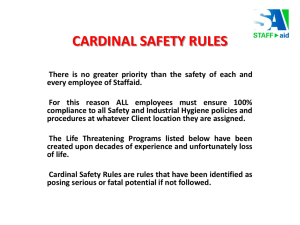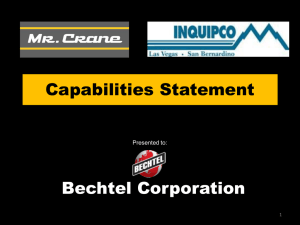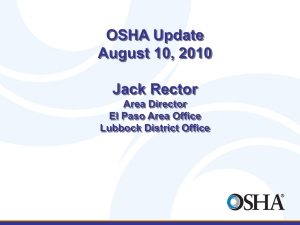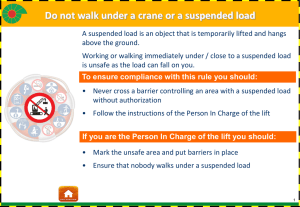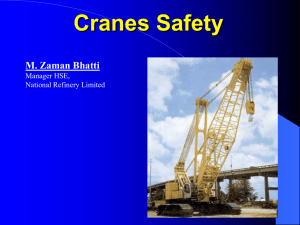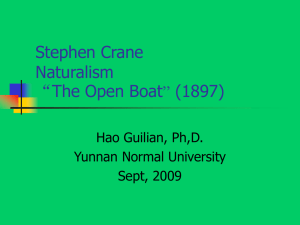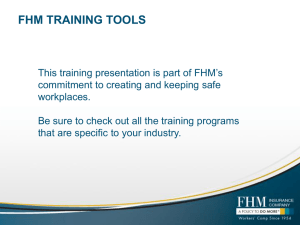Overhead Power Line Training
advertisement
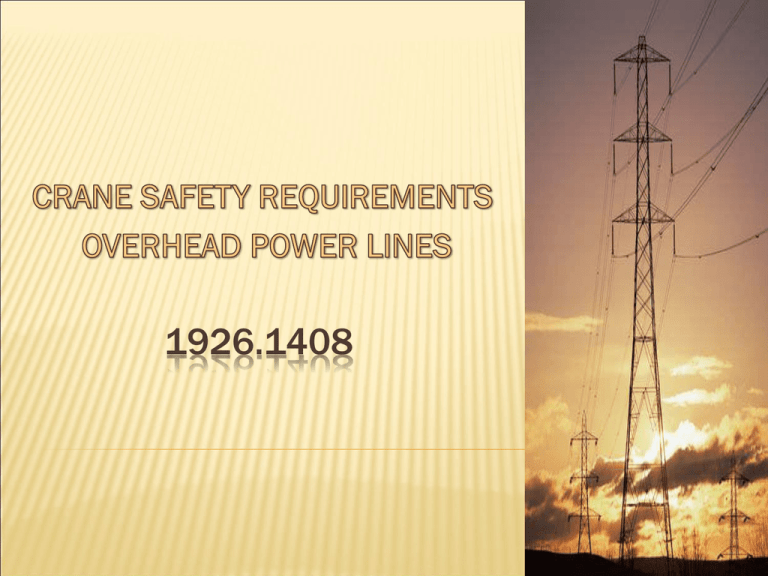
1926.1408 COMMON CAUSES OF CRANE FATALITIES Rigging Failure 15% Load Handling 14% Operator Error 7% Electrocution 44% Overload 7% Dismantling Boom 5% Wire Rope Failure 3% Struck by Crane 3% Miscellaneous 3% COMMON MYTHS COMMON MYTHS COMMON MYTHS ALWAYS ASSUME POWER LINES TO BE LIVE! This video displays the effects of a crew assuming the overhead lines were phone or cable, and not electrical. Always assume overhead lines to be electrical and live unless the utility company has provided notice that they have been de-energized, and they are visibly grounded. POWER LINE HAZARD ASSESSMENT MUST BE COMPLETED FOR EACH JOB CRANE IS USED ON STEP 1: DESIGNATE WORK ZONE For every job which we use a crane, we must first designate the work zone. OPTION 1 OPTION 2 Designate the work zone as the maximum working radius 360 degrees around the crane Use elevated visual aids such as warning lines to mark boundaries of the work zone. Not required to fully barricade the entire work zone (example would be a short row of lines on each side of the crane signaling where operator cannot swing past and a row at the far reach displaying the area that can’t be boomed past) POWER LINE HAZARD ASSESSMENT STEP 2: IN “WORK ZONE” DETERMINE IF CRANE OR RIGGING CAN GET WITHIN 20’ OF POWER LINES NO YES No further action necessary Choose option below and have planning meeting w/all onsite to discuss OPTION 1: Have utility company deenergize & ground OPTION 2: Maintain 20’ clearance at all times by placing elevated warning lines 20’ from power lines and having a dedicated spotter monitor distance when approaching OPTION 3: (use if needed to get close to lines than 20’) Ask utility company for exact voltage, and maintain distance requirements of Table A (next slide) by using elevated lines & spotter listed in option 2 Table A – Minimum Clearance Distances Voltage (nominal, kV, alternating current) Minimum clearance distance (feet) up to 50 over 50 to 200 over 200 to 350 over 350 to 500 10 15 20 25 over 500 to 750 over 750 to 1000 over 1000 35 45 (as established by the power line owner/operator or registered professional engineer who is a qualified person with respect to electrical power transmission and distribution) POWER LINE HAZARD ASSESSMENT The hazard assessment criteria on the previous three slides discusses procedures assuming the power lines are not known exactly and presumed to be 350kV or less, which is our typical working environment. When power lines are presumed to be very high voltages and over 350kV, the minimum distance kept must be 50’, rather than the 20’ discussed for voltages of 350kV and lower. WORKING AROUND POWER LINES Whenever power lines are within the pre-determined “work zone” and tag lines are used, the tag lines must be of non-conductive material. A “dedicated spotter” or motion limiting device must be used to ensure the crane does not get within the minimum distance of the power lines. This spotter must be a qualified signal person capable of signaling the crane DEALING WITH POWER LINE EMERGENCIES In the unlikely event that contact with a power line occurs, the response of those on or around power lines is critical. In general, riggers and other workers working around the crane are in the most danger, however operators leaving the cab or operating from the ground can receive injury or death. The operator sitting in the cab on the left is at the same electrical potential as the crane, therefore is most likely not affected, however the operator on the right working from the ground, riggers and those around the crane at in significant danger. DEALING WITH POWER LINE CONTACT • • After the crane contacts power lines, the current flows through the crane and finally through the ground in a ripple pattern. Areas of high and low fields circle the crane like ripples in a pond after a stone hits the surface. If a worker steps from between ripples, from an area of higher potential to one of lower, the electricity can flow between their legs and cause injury or death. OPERATORS SHOULD NOT LEAVE THE CAB UNLESS ABSOLUTELY NECESSARY (fire for example) IF EXITING CAB, JUMP FROM CAB AND SHUFFLE FEET IN VERY SMALL STEPS AS YOU WORK AWAY FROM THE CRANE PROCEDURES TO FOLLOW IF CONTACT OCCURS Crane operator should remain inside the cab All other employees must keep away from the crane, ropes, and load since the ground around the crane might be energized Crane operator should attempt to remove the crane from contact by moving it in the reverse direction which caused the contact If crane cannot be moved from contact, operator should remain in the cab until power is de-energized If operator must leave because of immediate hazard, jump from equipment and shuffle feet in very small steps Others should secure the area and keep all except for emergency rescue who are aware of the hazard away QUESTIONS?
